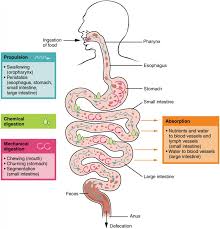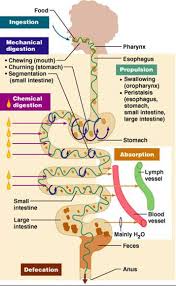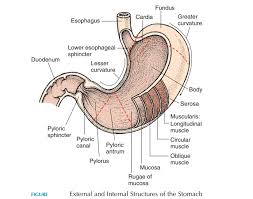In this text, you’ll dive deep into the world of mechanical digestion, exploring its role and why it’s essential for your overall health. From the moment food enters your mouth to when it’s prepared for chemical digestion, you’re about to uncover the fascinating mechanics behind how your body processes what you eat. Get ready to be amazed by the efficiency and intricacy of your digestive system.
Key Takeaways
- Mechanical digestion is the first crucial step for nutrient absorption, involving the physical breakdown of food through chewing and stomach churning.
- Salivary enzymes like amylase initiate the breakdown of carbohydrates, highlighting the importance of the chemical process beginning in the mouth.
- Peristalsis is the rhythmic contraction that moves food through the esophagus, showcasing the body’s ability to transport food seamlessly to the stomach.
- Hydrochloric acid in the stomach serves to create an acidic environment, activate digestive enzymes like pepsin, and protect against microbes.
- The interplay between mechanical and chemical digestion is essential for optimal nutrient absorption, energy levels, and overall well-being.
The Journey from Mouth to Stomach: Mechanical Digestion at Work

Role of Chewing in Mechanical Digestion
Chewing is the unsung hero of digestion, setting the stage for the entire digestive process. Proper chewing transforms food into a soft bolus, enhancing the efficiency of nutrient absorption. It’s not merely about comfort during swallowing; it’s about optimizing the food for enzymatic action.
- Mechanical Digestion is Crucial for Nutrient Absorption: It begins with chewing, which increases the food’s surface area, making it more accessible to digestive enzymes.
- Chewing Plays a Fundamental Role: Effective mastication leads to better nutrient breakdown and absorption, impacting overall digestive health.
Understanding the role of chewing in mechanical digestion is essential. It’s the first step that influences the entire journey of food through the digestive system, affecting energy levels and well-being.
The Significance of Salivary Enzymes
Saliva, produced by the salivary glands, is more than just a facilitator for swallowing. It plays a crucial role in the initial stage of digestion through its enzyme content. Salivary amylase, for example, begins the breakdown of carbohydrates right in the mouth, setting the stage for efficient nutrient absorption later in the digestive process.
- Increased Enzyme Activity: Amylase in saliva starts breaking down carbohydrates immediately upon mixing with food.
- Easier Digestion: Smaller food particles, thanks to thorough chewing, are more manageable for the stomach and intestines.
Efficient mechanical digestion, aided by salivary enzymes, is indispensable for overall health and digestive efficiency.
By the time food reaches the stomach, it has already undergone significant transformation, thanks to the early intervention of salivary enzymes. This early start is vital for the seamless continuation of the digestive process.
Peristalsis: The Esophageal Conveyor Belt
Once the process of chewing has transformed the food into a bolus, it embarks on a downward journey through the esophagus. Peristalsis, a series of wave-like muscle contractions, guides the bolus towards the stomach with remarkable coordination. The esophagus, acting as a muscular conveyor belt, ensures that food is delivered efficiently to the next stage of digestion.
The rhythmic contractions of the esophagus are essential for moving food reliably and safely from the mouth to the stomach, regardless of the body’s position.
The mechanics of peristalsis can be broken down into a few key steps:
- The circular muscles contract behind the bolus, creating a narrow region.
- Longitudinal muscles ahead of the bolus contract to shorten the distance it must travel.
- The contraction sequence repeats, propelling the bolus forward.
This elegant system allows the esophagus to transport food seamlessly, even against the force of gravity when we’re standing or sitting upright.
The Stomach: A Closer Look at Mechanical and Chemical Digestion

The Churning Power of Stomach Muscles
Upon arrival in the stomach, mechanical digestion takes on a more aggressive form. The stomach’s muscular walls vigorously contract, churning the food and mixing it with gastric juices. This action is essential for transforming the food into a semi-liquid substance called chyme, readying it for the small intestine, where nutrient extraction reaches its peak.
The stomach’s role is pivotal in ensuring that solid pieces of food are broken down into smaller particles, further aiding the digestive process.
Mechanical digestion is crucial for nutrient absorption as it increases the surface area for enzymes to act upon. Here’s how the stomach muscles contribute to this process:
- They contract and churn the bolus, now mixed with gastric juices.
- This movement ensures that solid food is broken down into smaller particles.
- The process prepares food for chemical digestion and nutrient absorption in the small intestine.
Gastric Juices: Composition and Function
Once the food reaches the stomach, it encounters the potent blend of gastric juices. These juices are crucial for digestion, as they contain hydrochloric acid, the enzyme pepsin, and mucus. Hydrochloric acid serves a dual purpose: it not only creates an acidic environment optimal for the enzymes to function but also acts as a defender against pathogens, killing bacteria that may have been ingested with the food.
Pepsin is the primary enzyme in the stomach, initiating the digestion of proteins by breaking them down into smaller peptides. This process is highly dependent on the acidic conditions provided by hydrochloric acid. Without this acid, pepsin would remain inactive and unable to perform its role.
The gastric mucus plays a protective role, coating the stomach lining to prevent damage from the acidic secretions. If this mucus barrier is compromised, the stomach lining can become susceptible to ulcers.
The composition of gastric juices is a delicate balance that facilitates the transformation of solid food into chyme, a semi-solid paste, over the course of 3-4 hours of churning. This churning action, combined with the chemical breakdown by gastric juices, prepares the food for its next stage of digestion in the small intestine.
From Solid Bites to Chyme: The Transformation
Once the bolus of food reaches the stomach, it encounters a powerful muscular action that is pivotal in the digestive process. The stomach muscles contract rhythmically, transforming the bolus into chyme, a semi-liquid mixture of partially digested food and gastric juices. This mechanical digestion is crucial as it ensures that food particles are sufficiently small for chemical digestion to be effective.
The chyme is then ready to move on to the small intestine, where it will undergo further digestion and nutrient absorption. The table below summarizes the transformation process from solid bites to chyme:
| Stage | Action | Result |
|---|---|---|
| 1 | Chewing in the mouth | Bolus formation |
| 2 | Peristalsis down the esophagus | Bolus reaches stomach |
| 3 | Stomach muscle contractions | Chyme formation |
The seamless transition from mechanical to chemical digestion is essential for the body to absorb all possible nutrients efficiently.
As the chyme passes from the stomach to the small intestine, the digestive system prepares for a shift in focus towards chemical digestion. However, the presence of chyme ensures that enzymes have ample surface area to act upon, which is vital for the efficient absorption of nutrients into the bloodstream.
The Role of Hydrochloric Acid in Digestion

Acidic Environment and Its Purpose
The stomach’s acidic environment is crucial for digestion. Hydrochloric acid (HCl) serves multiple functions, including the breakdown of food and acting as a defense mechanism against pathogens. The low pH level of the stomach ensures that most bacteria and viruses that enter with food are destroyed, safeguarding our health.
- Hydrochloric Acid:
- Kills bacteria in food
- Creates an acidic environment for enzymes
- Pepsin:
- Begins protein digestion in the stomach
- Operates optimally in acidic conditions
Mucus plays a protective role, shielding the stomach lining from the corrosive effects of HCl. Without this mucus barrier, the stomach’s own acid could cause harm, leading to ulcers. The balance between these components is a testament to the intricate design of our digestive system.
The highly acidic environment in the stomach not only facilitates the breakdown of food but also serves as a gatekeeper, preventing harmful microorganisms from entering our system and causing infections.
Pepsin Activation and Protein Breakdown
Once the acidic environment is established in the stomach, pepsinogen is converted into its active form, pepsin. Pepsin is a proteolytic enzyme, which means it’s responsible for breaking down proteins into smaller peptides and amino acids. This process is crucial for the body to utilize the proteins we consume in our diet.
The efficiency of pepsin’s activity is influenced by several factors, including the pepsin-to-substrate protein ratio and the duration of exposure. Optimal conditions allow pepsin to perform effectively, ensuring that proteins are sufficiently degraded for further digestion and absorption in the small intestine.
The transformation from pepsinogen to pepsin marks the beginning of significant protein digestion within the stomach, setting the stage for nutrient absorption later in the digestive process.
Protective Mechanisms Against Acid Damage
After the stomach has done its work, the partially digested food, now called chyme, is ready to move into the small intestine where chemical digestion takes center stage. The transition from the stomach to the small intestine is marked by a change in pH, which is crucial for the enzymes in the small intestine to function properly.
The body has remarkable mechanisms to protect itself from the corrosive effects of digestive acids. The stomach lining secretes mucus, which forms a barrier between the gastric acids and the stomach wall. This mucus is essential for preventing the degradation of the stomach lining and the formation of ulcers.
The pancreas also plays a role by secreting bicarbonate into the small intestine, which neutralizes the acidic chyme. This ensures that the environment in the small intestine is optimal for the pancreatic enzymes to break down carbohydrates, fats, and proteins.
- Mucus: Protects stomach lining
- Bicarbonate: Neutralizes acidity
- Pancreatic enzymes: Break down nutrients
Understanding these protective mechanisms is key to appreciating the intricate balance our body maintains to safeguard its own tissues while efficiently digesting the food we consume.
The Seamless Transition to Chemical Digestion

Enzymatic Breakdown of Nutrients
Once the mechanical digestion has prepared the food into smaller pieces, the enzymatic breakdown of nutrients begins. Digestive enzymes are specialized proteins that catalyze the conversion of complex food substances into absorbable forms. These enzymes are secreted by various organs, including the pancreas and the small intestine, and each targets specific types of nutrients.
- Carbohydrases break down carbohydrates into simple sugars.
- Proteases split proteins into amino acids.
- Lipases disassemble fats into fatty acids and glycerol.
The efficiency of these enzymes is crucial for the proper absorption of nutrients. Without them, our bodies would not be able to extract the energy and building blocks needed for cellular functions. The enzymatic process is highly selective, ensuring that each nutrient is broken down by the appropriate enzyme.
The precise action of digestive enzymes ensures that nutrients are ready for absorption at the right time and place within the digestive tract.
The Importance of a Balanced pH for Digestion
The digestive system is finely tuned to operate within a specific pH range, making the balance of acidity and alkalinity crucial for optimal function. A balanced pH is essential for enzyme activity, ensuring that digestive enzymes function at their peak efficiency. For instance, different enzymes activated at various stages of digestion require precise pH levels to break down carbohydrates, proteins, and fats effectively.
The pH level in the stomach and intestines must be carefully regulated to prevent damage to the lining and ensure that nutrients are properly absorbed.
The table below illustrates the optimal pH levels for key digestive enzymes:
| Enzyme | Optimal pH Range |
|---|---|
| Amylase | 6.7 – 7.0 |
| Pepsin | 1.5 – 2.0 |
| Lipase | 4.0 – 5.0 |
| Trypsin | 7.5 – 8.8 |
When the pH level strays from these optimal ranges, enzyme activity can be inhibited, leading to incomplete digestion and absorption of nutrients. This can result in gastrointestinal discomfort and a reduction in the nutritional value of foods. Maintaining a balanced pH is therefore not only important for digestion but also for overall health and well-being.
Absorption: The Final Destination of Nutrients
Once digestion has broken down food into its constituent nutrients, the final act of absorption takes place. Nutrients enter the bloodstream and are transported to cells throughout the body, where they are assimilated or stored for future use. The liver plays a pivotal role in this process, converting excess nutrients into glycogen for storage.
The large intestine completes the absorption process by reclaiming water and any remaining nutrients, such as vitamins produced by colonic bacteria. It also compacts waste into feces, storing it temporarily in the rectum. Here’s a brief overview of the nutrients absorbed in the large intestine:
- Water
- Vitamins (e.g., thiamine, riboflavin, vitamin K)
- Electrolytes (e.g., sodium, magnesium, chloride)
The efficiency of nutrient absorption is crucial for maintaining the body’s energy levels and overall well-being. Inadequate absorption can lead to nutrient deficiencies and health issues.
The journey from ingestion to absorption is a complex interplay of mechanical and chemical processes, each step fine-tuned to extract maximum nutritional value from the food we consume.
Understanding Digestion for Optimal Health

The Impact of Mindful Eating on Digestion
Mindful eating is more than just a practice; it’s a transformative approach that enhances digestive efficiency and overall health. By fully engaging in the act of eating—savoring each bite, chewing thoroughly, and avoiding distractions—our digestive system is primed for optimal performance. This intentional focus on the present moment during meals can lead to a more satisfying and effective digestive process.
Mindful eating encourages a slower pace, allowing the digestive system to keep up with the mechanical breakdown of food. This not only aids in nutrient absorption but also helps in managing portion sizes and recognizing satiety cues.
The benefits of mindful eating extend beyond the physical aspects of digestion. It fosters a deeper connection with our food, promoting a sense of gratitude and appreciation for the nourishment it provides. Here’s how mindful eating impacts the journey from mechanical to chemical digestion:
- Prepares food for chemical digestion: Proper chewing sets the stage for enzymes to work effectively.
- Increases enzyme activity: Saliva, rich in enzymes like amylase, begins the breakdown of carbohydrates.
- Easier digestion: Smaller particles are more manageable for the stomach and intestines.
By embracing mindful eating, we not only optimize nutrient absorption but also enhance our psychological well-being and body satisfaction.
The Intricate Dance Between Mechanical and Chemical Processes
The digestive system is a marvel of biological engineering, where mechanical and chemical digestion work in concert to transform the food we eat into the energy and nutrients our bodies need. Mechanical digestion begins in the mouth with chewing, breaking down food into smaller pieces, and continues in the stomach with the powerful churning of muscles. At the same time, chemical digestion takes over as enzymes and stomach acids join the fray, meticulously breaking down complex molecules.
The transition from mechanical to chemical digestion is seamless yet complex, ensuring that your body efficiently absorbs all possible nutrients.
Understanding this process is crucial for optimal health, as it highlights the importance of each step in preparing food for nutrient absorption. It underscores the need for mindful eating and thorough chewing, as the success of this intricate dance directly influences your energy levels and overall well-being.
How Digestion Influences Energy Levels and Well-being
The intricate process of digestion is not just about breaking down food; it’s about transforming it into the energy that fuels our lives. Efficient digestion is crucial for energy production and overall vitality. When digestion is optimized through practices like mindful eating, the body can extract and utilize nutrients more effectively, leading to improved energy levels and well-being.
- Impacts Overall Health and Digestive Efficiency
- Prepares Food for Chemical Digestion
- Mindful Eating Enhances Digestive Health
Remember, every step in the digestion process, from the moment you take your first bite, contributes to how well your body can use the food you consume.
The connection between digestion and energy is also evident in the common experience of post-meal tiredness, particularly after consuming high-fat or high-carbohydrate meals. These foods can be difficult to digest, leading to a temporary decrease in alertness as the body directs more energy towards the digestive system.
Conclusion
As we’ve journeyed through the complexities of the stomach’s role in digestion, it’s clear that the process is a marvel of biological engineering. Mechanical digestion, starting with the simple act of chewing, sets the stage for the intricate dance of enzymes and acids that break down our food into absorbable nutrients. The stomach’s muscular contractions and the transformative power of gastric juices create chyme, a crucial intermediary in nutrient extraction. This seamless transition from mechanical to chemical digestion is not just fascinating; it’s a testament to the efficiency of the human body. Understanding these processes underscores the importance of mindful eating and the impact of our dietary choices on our overall health. As we conclude, it’s worth reflecting on the incredible work our digestive system performs daily, often without a second thought from us, and the vital role it plays in sustaining life.
Frequently Asked Questions
What role does mechanical digestion play in our digestive system?
Mechanical digestion is the first step in the digestive process, which involves the physical breakdown of food into smaller pieces through chewing and stomach churning. This increases the surface area of the food, making it easier for enzymes to work on it and enhancing nutrient absorption.
How does the process of chewing affect digestion?
Chewing, also known as mastication, plays a fundamental role in mechanical digestion. Proper chewing breaks down food into smaller, more manageable pieces, increasing the efficiency of digestion and preparing food for chemical digestion in the stomach.
What is the significance of salivary enzymes in digestion?
Salivary enzymes, such as amylase, begin the digestive process in the mouth by starting the breakdown of carbohydrates. This early enzymatic activity is crucial for kickstarting digestion before food reaches the stomach.
What is peristalsis and how does it function in digestion?
Peristalsis is the series of wave-like muscle contractions that move food through the esophagus to the stomach. It acts like a conveyor belt, ensuring that the bolus (chewed food) is efficiently transported from the mouth to the stomach for further digestion.
How does hydrochloric acid contribute to the digestive process?
Hydrochloric acid in the stomach creates an acidic environment that serves multiple purposes, including the activation of the enzyme pepsin for protein breakdown, and providing a defense against pathogens ingested with food.
What is chyme and how is it formed in the stomach?
Chyme is a semi-liquid substance formed in the stomach when food is mixed with gastric juices. The stomach’s muscular walls contract and churn the food, breaking it down mechanically and mixing it with digestive enzymes and acids to form chyme, which is then ready for the next stage of digestion in the small intestine.








This article is a gem! The information you’ve provided is not only helpful but also presented in an engaging way.